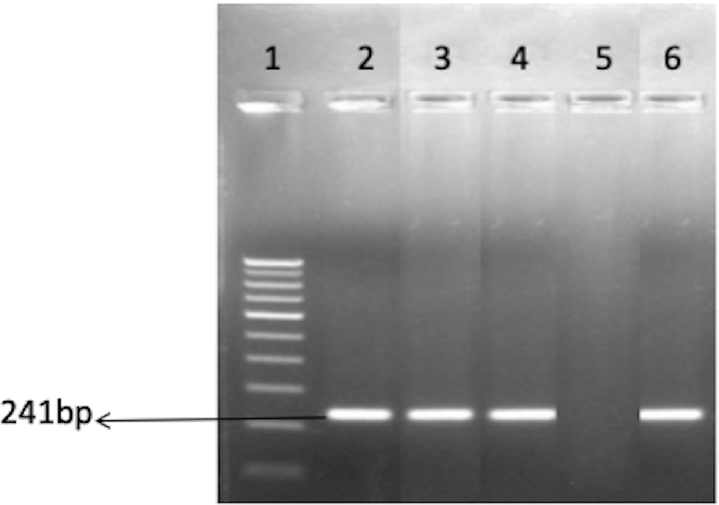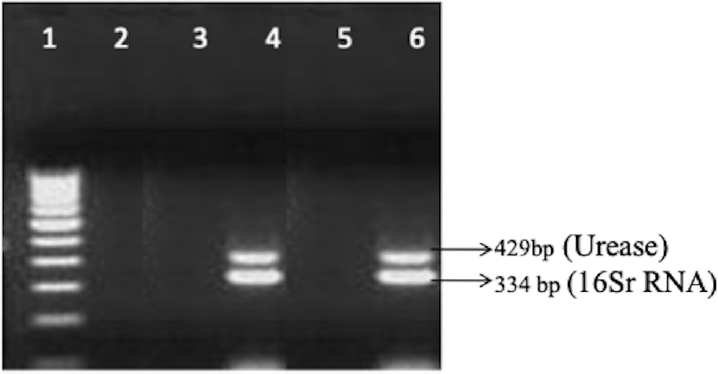Translate this page into:
Chlamydia trachomatis, Mycoplasma genitalium, Mycoplasma hominis, and Ureaplasma spp. Coinfection in an HIV-Positive Homosexual Man
Address for correspondence: Benu Dhawan, MD, Department of Microbiology, All India Institute of Medical Sciences, Ansari Nagar, New Delhi, 110029, India (e-mail: dhawanb@gmail.com).
This article was originally published by Thieme Medical and Scientific Publishers Pvt. Ltd. and was migrated to Scientific Scholar after the change of Publisher.
Abstract
A 21-year-old human immunodeficiency virus-positive male patient presented with complaints of multiple hyperpigmented verrucous papules over his perianal area. He reported having unprotected anal and oral sex with multiple male partners. On examination, superficial ill-defined perianal erosions were present. A first void urine sample and clinician-collected rectal and oropharyngeal swabs were sent for the detection of Chlamydia trachomatis, Mycoplasma genitalium, Mycoplasma hominis, and Ureaplasma spp. Rectal swab tested positive for all the four pathogens. Oropharyngeal swab and urine samples tested positive for C. trachomatis. The patient was treated with doxycycline and moxifloxacin. This case underscores the importance of screening of men who have sex with men for possible coinfections with multiple sexually transmitted pathogens.
Keywords
coinfection
men who have sex with men
extragenital STIs
Introduction
Men who have sex with men (MSM) are considered at high risk of sexually transmitted infections (STIs). Agents like Chlamydia trachomatis and genital mycoplasmas can potentially influence and increase the acquisition and transmission of other STIs including human immunodeficiency virus (HIV).[1]
Coinfection of C. trachomatis with either Mycoplasma hominis, Ureaplasma spp., or Mycoplasma genitalium has been reported in literature.[2-4] We report a case of coinfection of these four pathogens in an HIV-positive MSM.
Case Report
A 21-year-old male patient presented to the STI clinic with complaints of multiple hyperpigmented verrucous papules over his perianal area for the previous 3 months, previously managed at a private hospital by local podophyllum application, to which he had partially responded. The patient did not give any history of genital ulcer or urethral discharge. He gave sexual history of homosexual behavior and reported having unprotected anal and oral sex with multiple male partners. The patient was HIV-positive and already on TLE regimen (tenofovir + lamivudine + efavirenz) with a baseline CD4 count of 475. On clinical examination, superficial ill-defined perianal erosions were present at the sites of podophyllum application. There were no lesions or inflammation in the rectum. He did not have any active genital warts or lymphadenopathy. Examination of the oral cavity revealed pharyngeal congestion.
Laboratory records revealed that the patient was seronegative for hepatitis B (HbsAg), hepatitis C, and syphilis (VDRL). Microscopic examination of Gram-stained smear of the urethral swab revealed two to three pus cells per oil-immersion field and no gram-negative intracellular diplococci were seen. A first void urine sample and rectal and oropharyngeal swabs were sent for the detection of C. trachomatis and genital mycoplasmas. In-house polymerase chain reaction (PCR) was performed for C. trachomatis targeting cryptic plasmid (►Table 1). Briefly, the 25 μL reaction mixture contained 2.5 μL of 10× PCR buffer (1× PCR buffer is 10 mmol/L Tris-HCl [pH 8.8 at 25°C], 1.5 mmol/L MgCl2 50 mmol/L KCl, and 0.1% Triton X-100), 200 μmol/L (each) deoxynucleoside triphosphate (dNTPs) mixture, 10 pmol of each primer, 2U of Taq DNA polymerase, 5 μL of sample DNA, and ultrapure sterile water. In-house PCR for M. genitalium targeting the 140kDa adhesion gene was performed (►Table 1). The 25 μL reaction mixture contained 2.5 μL of 10× PCR buffer (1× PCR buffer is 10 mmol/L Tris-HCl [pH 8.8 at 25°C], 50 mmol/L KCl, and 0.1% Triton X-100), 4.5mM MgCl2, 1U of Taq polymerase, 250 μmol/L (each) dNTPs mixture, 20 pmol of each primer, 5 μL of sample DNA, and ultrapure sterile water. Multiplex PCR was performed for urease gene of Ureaplasma spp. and 16S rDNA of M. hominis (►Table 1). Briefly, the 50 μL reaction mixture contained 5 μL of 10× PCR buffer (1× PCR buffer is 10 mmol/L Tris-HCl [pH 8.8 at 25°C], 50 mmol/L KCl, and 0.1% Triton X-100), 3.0 mM MgCl2, 1.25U Taq polymerase, 400 μmol/L (each) dNTPs, 25 pmol of each primer, 16 μL of sample DNA, and ultrapure sterile water.
| Organism | Target | Primer sequence | Cycling conditions | ||
|---|---|---|---|---|---|
| Chlamydia trachomatis | Cryptic plasmid | KL1 5′-TCCGGAGCGAGTTACGAAGA-3′ KL2 5′-AATCAATGCCCGGGATTGGT-3′ |
Denaturation | 94°C for 1 min | 35 cycles |
| Annealing | 55°C for 2 min | ||||
| Extension | 72°C for 1 min | ||||
| Mycoplasma genitalium | Adhesin gene | MgPa1 5′- AGTTGTGAAACCTTAACCCTTGG-3′ MgPa3 5′-CCGTTGAGGGGTTTTCCATTTTTGC-3 |
Initial denaturation | 95°C for 1 min | |
| Denaturation | 95°C for 1 min | 35 cycles | |||
| Annealing | 67°C for 15 sec | ||||
| Extension | 72°C for 6 min | ||||
| Ureaplasma spp. M. hominis | Urease, 16S rDNA (Multiplex) | U4 5′-ACGACGTCCATAAGCAACT-3′ U5 5′-CAATCTGCTCGTGAAGTAATTAC-3′ RNAH1 5′-CAATGGCTAATGCCGGATACGC-3′ RNAH2 5′-GGTACCGTCAGTCT-3′ |
Initial denaturation | 95°C for 10 min | |
| Denaturation | 95°C for 15 sec | 35 cycles | |||
| Annealing | 60°C for 1 min | ||||
| Extension | 72°C for 5 min | ||||
Abbreviation: PCR, polymerase chain reaction.
A negative control in the form of template free master mix solution was included in each run of amplification. To eliminate the cross-contamination and thereby to overcome false-positives, before amplification master mix containing nuclease-free water, Taq Buffer B, MgCl2, and Taq DNA polymerase were incubated for 15 minutes with 0.1 IU of uracil N-glycosylase enzyme. After incubation, dNTP mix and primers were carried out in a final master mix.
The rectal swab tested positive for all the four pathogens. However, oropharyngeal swab and urine sample tested positive for C. trachomatis alone (►Figs 1–3).

- Gel electrophoresis picture of the polymerase chain reaction for Chlamydia trachomatis targeting cryptic plasmid and ompA gene. Lane 1, 100 bp ladder; Lane 2, urine sample (positive); Lane 3, rectal swab (positive); Lane 4, oropharyngeal swab (positive); Lane 5, negative control; Lane 6, positive control (ATCC VR-885).

- Gel electrophoresis picture of the polymerase chain reaction for Mycoplasma genitalium targeting adhesion gene. Lane 1, 100 bp ladder; Lane 2, positive control; Lane 3, urine sample (negative); Lane 4, rectal swab (positive); Lane 5, oropharyngeal swab (negative); Lane 6, negative control.

- Gel electrophoresis picture of the multiplex-polymerase chain reaction for Ureaplasma spp. and Mycoplasma hominis targeting urease gene and 16S ribosomal DNA, respectively. Lane 1, 100 bp ladder; Lane 2, negative control; Lane 3, urine sample (negative); Lane 4, rectal swab (positive for Ureaplasma and M. hominis); Lane 5, oropharyngeal swab (negative); Lane 6, positive control (Ureaplasma NCTC 10177, urease positive; M. hominis NCTC 10111, 16S rRNA positive).
The patient was treated with oral doxycycline 100 mg twice daily for 7 days. However, in view of decreased efficacy of doxycycline in M. genitalium infection, moxifloxacin 400mg was given once daily for another 7 days. Partner treatment could not be done as the patient was not willing to inform his partners about his condition. However, he was advised abstinence during the treatment period. Posttreatment, patient's first void urine sample and rectal and oropharyngeal swabs tested negative for all the four pathogens. There were no new genital complaints and the patient was counselled for safe sex practices.
Discussion
Genital mycoplasmas and C. trachomatis have commonly been implicated as copathogens in HIV-infected patients. Presence of one agent warrants testing for other sexually transmitted organisms especially in high-risk patients. Extragenital sites are believed to serve as hidden reservoirs for ongoing transmission of infection and their treatment is also different compared to that of genital infection. Most MSMs report bisexual behavior and such patients can act as a bridge population in spreading various STIs.[5]
Extragenital STIs especially rectal infections are often asymptomatic. In a study, Foschi et al reported 63.1% asymptomatic rectal infections due to C. trachomatis, Neisseria gonorrhoeae, and M. genitalium in MSMs and that 80% of these infections would have gone undetected in absence of rectal site testing.[6] Our patient also had asymptomatic rectal infection. Infection with Ureaplasma, M. hominis, M. genitalium, and C. trachomatis would have been missed had rectal sample not been tested. Hence, extragenital screening becomes vital due to the asymptomatic nature of these infections.
The MSM population can be exposed to these pathogens in a number of ways making a detailed sexual history and thorough clinical examination crucial in such patients. Centers for Disease Control and Prevention recommends annual screening of all MSMs for syphilis, chlamydia, and gonorrhea, 3 to 6 monthly screening of MSMs with persisting high-risk behavior with multiple partners.[7] PCR is a preferred approach for screening of these patients. Although cultures have historically been the gold standard, they are subjective and PCR offers to be a more sensitive and specific testing modality.
Ureaplasma has been reported to cause non-gonococcal urethritis, prenatal infections and complications during pregnancy. Ureaplasma offers a survival advantage for C. trachomatis by disturbing the genital tract homeostasis.[8,9] However, there are no guidelines for the screening or testing of Ureaplasma spp. or Mycoplasma spp. in extragenital sites.
M. genitalium infections are reported to present as coinfections. Pépin et al showed that almost half of the M. genitalium infections were coinfections. In their study, the prevalence of coinfection of M. genitalium with N. gonorrhoeae, C. trachomatis, and Trichomonas vaginalis was 37.9, 10.6, and 7.6%, respectively.[10] Rates of detection of M. genitalium have been reported higher in MSM population who are HIV-positive.[11] Therefore, attention should be paid to these infections among MSMs, especially bisexuals, which might have critical implications not only for effective HIV/STD control but also for obstetric and gynecological complications in female partners.
Conclusion
To our knowledge, this is the first report of coinfection with C. trachomatis, M. hominis, M. genitalium, and Ureaplasma spp. in an HIV-positive MSM. This case underscores the importance of testing both genital and extragenital sites in MSMs for C. trachomatis and genital mycoplasmas. Timely testing can result in early initiation of targeted interventions and along with behavioral counseling can in turn help in reducing STI burden by breaking the chain of transmission.
Acknowledgement
We thank Manoj Kumar for his technical assistance.
Conflict of Interest
None.
References
- et al The associations between cervicovaginal HIV shedding, sexually transmitted diseases and immunosuppression in female sex workers in Abidjan, Côte d’Ivoire. AIDS. 1997;11(12):F85-F93.
- [CrossRef] [PubMed] [Google Scholar]
- Co-infections with Ureaplasma parvum, Mycoplasma hominis and Chlamydia trachomatis in a human immunodeficiency virus positive woman with vaginal discharge. Indian J Med Microbiol. 2013;31(02):190-192.
- [Google Scholar]
- et al Simultaneous detection and identification of STI pathogens by multiplex real-time PCR in genital tract specimens in a selected area of Apulia, a region of Southern Italy. Infection. 2017;45(04):469-477.
- [CrossRef] [PubMed] [Google Scholar]
- Co-infection of Mycoplasma genitalium and Chlamydia trachomatis in an infertile female patient with genital tuberculosis. Indian J Pathol Microbiol. 2013;56(04):457-459.
- [CrossRef] [PubMed] [Google Scholar]
- Homosexual activity among rural Indian men: implications for HIV interventions. AIDS. 2004;18(13):1845-1847.
- [CrossRef] [PubMed] [Google Scholar]
- Sexually transmitted rectal infections in a cohort of ‘men having sex with men’. J Med Microbiol. 2018;67(08):1050-1057.
- [CrossRef] [PubMed] [Google Scholar]
- Centers for Disease Control and Prevention. Sexually transmitted diseases treatment guidelines, 2015. MMWR Recomm Rep. 2015;64(RR-03):1-137.
- [Google Scholar]
- Species identification and subtyping of Ureaplasma parvum and Ureaplasma urealyticum using PCR-based assays. J Clin Microbiol. 2000;38(03):1175-1179.
- [CrossRef] [PubMed] [Google Scholar]
- Clinical relevance of Ureaplasma urealyticum colonization in preterm infants. Acta Paediatr. 1998;87(10):1075-1078.
- [CrossRef] [PubMed] [Google Scholar]
- et al Etiology of urethral discharge in West Africa: the role of Mycoplasma genitalium and Trichomonas vaginalis. Bull World Health Organ. 2001;79(02):118-126.
- [Google Scholar]
- et al The prevalence of urethral and rectal Mycoplasma genitalium and its associations in men who have sex with men attending a genitourinary medicine clinic. Sex Transm Infect. 2010;86(01):21-24.
- [CrossRef] [PubMed] [Google Scholar]





